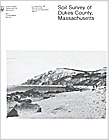The following map unit description is from the published "Soil Survey of Dukes County, Massachusetts"

Soil Survey of
Dukes County Massachusetts
The following map unit description is from the published "Soil
Survey of Dukes County, Massachusetts"

FsA-Freetown and Swansea mucks, O to 1 percent slopes. These soils are very deep, level, and very poorly drained. They are in depressions and areas adjacent to streams and bodies of open water. The areas are irregular in shape and range from 3 to 50 acres. They make up about 2 percent of the survey area. Some areas consist mostly of Freetown soils, some mostly of Swansea soils, and some of both. The Freetown and Swansea soils were mapped together because there are no major differences in their use and management. The total acreage of the unit is about 45 percent Freetown soils, 35 percent Swansea soils, and 20 percent other soils.
Typically, the Freetown soils consists of layers of dark reddish brown and black muck to a depth of 60 inches or more.
Typically, the Swansea soils have a surface layer of dark reddish brown muck about 19 inches thick. The substratum is multicolored coarse sand to a depth of 60 inches or more.
Included with this unit in mapping are areas of Berryland, Pompton, and Whitman soils. Also included are areas that were formerly cranberry bogs. They have a surface layer of coarse sand 5 to 12 inches thick over the muck. Some areas have water ponded on the surface most of the year.
The permeability of these Freetown soils is moderate or moderately rapid. The permeability of these Swansea soils is moderate or moderately rapid in the organic material and very rapid in the substratum. Available water capacity is very high in both soils. A high water table is at or near the surface most of the year, and water is ponded on some areas.
Most areas of these soils are wooded or have shrubby vegetation.
The high water table makes these soils generally unsuited to cultivated crops except cranberries. Drainage is hampered because suitable outlets are difficult to establish and maintain.
These soils are poorly suited to woodland productivity because of a high water table, a high rate of seedling mortality, and a hazard of uprooting. Because of low soil strength, equipment can be used only when the soil is frozen. The common trees on this unit are red maple, tupelo, and Atlantic white-cedar.
The high water table and low strength limit these soils for most types of nonfarm use other than as wetland wildlife habitat.
This unit is in capability subclass Vw.